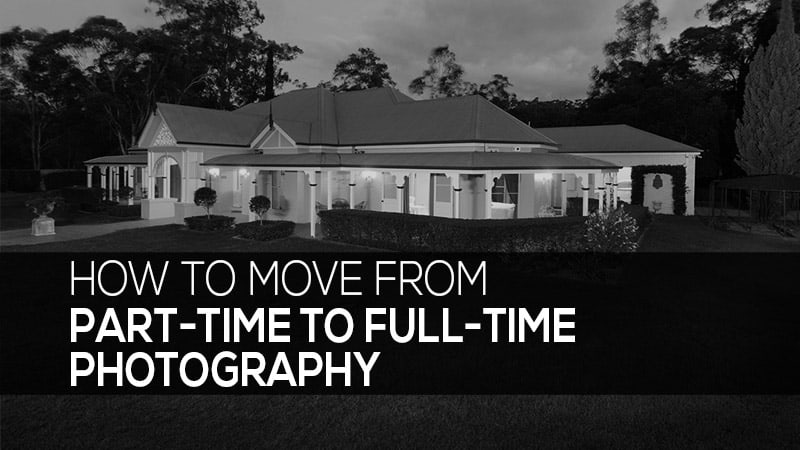Real estate photographers: In this video I give you a 5-step plan for how you can transition from part-time to full-time photography.
This process will work through your reasons for changing, provide objective criteria by which you can determine when you should make the switch, and give you certainty around what you need to do beyond just ‘getting more clients’.
Would you like me to help?
If you like what you've seen but you're not sure you can do it on your own, then think about joining my real estate photography coaching program where I’ve got over 500 training modules, including ones covering the topics in this video. We meet for group calls every week, and I’m available for 1-to-1 coaching calls as well.
Video transcript:
Do you want to move from part-time to full-time real estate photography?
There are a lot of different ways to do this, but I’d like to share with you the 5 step plan that I’m comfortable with, and I’m confident that this should work for most of you because it’s simple, it makes the timing of your move an objective one instead of based on your insecurities, and it will help you get things really well planned, and who doesn’t love a great plan? Alright, let’s take a closer look!
So how might you make the transition from part-time to full-time photography? I’d break it down into 5 steps, and here they are:
Step 1: Is it really what you want?
Step 1 is to decide if full-time shooting is really what you want, or if it’s just something that you think is expected of you. Now this is a big decision, so it’s not something you want to do unless you’re fully committed, so here’s what you need to ask yourself:
Do you want to have so much of your life being dependent on your success in photography, in particular when it comes to the security of yourself and your family, or would you prefer to keep it as a side gig?
Now there’s no right or wrong answer here, but if you go full-time you need to love the business side of things as well as photography. What I’ve seen is that some photographers really love the creative side of taking photos, but the business side is not something they really want to do, and if that’s you then keeping photography as a part-time gig is probably the best thing you can do.
That’s not something to be looked down upon either – just because you stay part-time doesn’t mean you’ve failed as a photographer. It’s just another way of doing things, and if it’s the right way for you then it’s probably the best thing you can do.
Step 2. Set times in your calendar
If you want to go full-time then step 2 is to have set times in your calendar for marketing and times for shooting. You need to make time for both of those things.
So for example, you might block out 8 hours a week for shooting, and another 3 hours for marketing, and you set those times aside week after week, and nothing can move them away.
Now if you are so busy that you don’t have time to do any marketing, then this transition to full time shooting may not work out for you because jobs don’t magically come your way. It takes work and resources, and so make sure you set time aside to build new connections and follow-up with those agents and business owners that you want to be working with.
Step 3. Set a target.
Step 3 is to set a target for the volume of work you need to reach before you can go full-time, and that’s because you want to be very objective with this decision and base it on the numbers and really let them guide you on when you’ll make the shift.
For example, will you go full-time only when you completely meet your current full-time income, or would you be happy to get part way there and then trust that you’ll meet that financial goal after you go full-time? For example, will you switch to full-time once you do turnover of $5000 for 3 months in a row?
That’s just one example, but what’s important is that you don’t want to base this on a short period of time, like one good month in a sea of average months, and that’s because things can easily fluctuate, so make sure you observe this continuity of work over a sustained length of time if a particular financial goal is important for you.
Step 4. Commit to your goals
Step 4 is to commit to meeting your goals for marketing and shooting, and actually get stuff done. So the previous 3 steps are all about planning, but step 4 is all about doing.
You can’t just talk about it – you need to do it, so this is where you’re actually delivering fantastic photos and other services, together with an ongoing marketing program that builds connections with the right people and communicates the value of what you deliver.
Now for more on marketing and how you get more clients, have a look at my videos about offline and online marketing.
Step 5. Make the transition
Finally we get to step 5, and you get to this step once you reach your financial goal. So you might have been shooting part-time for the past 12 months, but you’ve now hit your goal of $5000 per month for the last 3 months in a row, and it’s time to make the switch to full-time work … so how do you make that transition?
Again, that’s where some planning might be helpful, even if that move is 12 months away from today. For example, what’s the process around leaving your current employer, and how much notice do you need to give them? How will that work? Start thinking about what you might need to do now.
Another thing you might want to do is to build an exit strategy for what you’ll do if you go full-time and it doesn’t work out. I don’t want to be negative here, but it is worth thinking about, and in fact it might actually give you more confidence to make this move if you’ve planned an exit strategy.
I mean, what's the worst thing that can happen? You try going full-time, it doesn't work out, so you move on to something else and life goes on. You recover. You get over it, but at least you tried.
So if you're not real sure about moving to full-time, then think about this - how will you be if you have that regret of never even giving it a go, so you're stuck doing some other job that you're not passionate about, instead of this? To me, not making the jump and not pursuing your dream is the bigger problem, and that's because real pain is in the regret, it's not in the trying.
So in regard to the transition from part-time to full-time photography, it would help you if you have some idea of what’s going to happen, and when it’s going to happen, so think about that now so that you can resolve any issues that might show up before you get to that point in time.
Conclusion:
So anyway, those are the 5 steps that you might like to go through if you are wanting to transition from part-time to full-time photography, so hopefully that’s given you a bit of context for your own plan and what you want to do.
Need some help?
If you would like some help with this then I run a coaching program for part-time and full-time real estate photographers, and I help them plan ahead, and bring some clarity when it comes to decision making, and that’s like gold when you’re running your own business because some times that lack of decision making is what really holds us back.
My name’s Darryl Stringer. If you liked this video make sure you leave a comment and subscribe or Like this Page, and I’ll see you next time. Bye for now!

